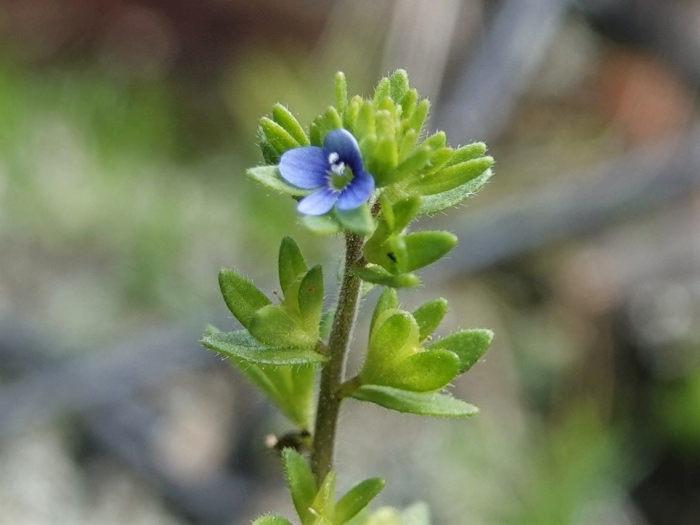Wall Speedwell
(Veronica arvensis)
Wall Speedwell (Veronica arvensis)
/
/

Jacqui Geux
CC BY 4.0
Image By:
Jacqui Geux
Recorded By:
Copyright:
CC BY 4.0
Copyright Notice:
Photo by: Jacqui Geux | License Type: CC BY 4.0 | License URL: http://creativecommons.org/licenses/by/4.0/ | Rights Holder: Jacqui Geux | Publisher: iNaturalist | Date Created: 2019-10-04T14:44:52-07:00 |













Estimated Native Range
Summary
Veronica arvensis, commonly known as wall speedwell, is a hairy annual herb that is native to a variety of habitats including open woodlands, grasslands, and rocky outcrops in Europe, Africa, and Asia. It typically grows to a height of 4 to 16 inches. Wall speedwell has a sprawling or erect habit with small, ovate to lanceolate leaves that are oppositely arranged along the stem. From spring to summer, it produces small, pale blue to blue-violet flowers in loose racemes, which are modest in appearance but can add a sprinkle of color to the landscape.
Wall speedwell is valued for its ability to fill in bare spots in the garden and its resilience in a variety of soil conditions. It can be used as a ground cover or in rock gardens and is appreciated for its low maintenance requirements. It thrives in full sun to part shade and prefers well-drained soils but can tolerate a range of soil types, including those that are poor or rocky. While it is not commonly grown for culinary or medicinal purposes, it has been used traditionally in herbal medicine. Gardeners should be aware that Veronica arvensis can self-seed prolifically and may become weedy or invasive outside its native range, so it is important to manage its spread to prevent unwanted colonization.CC BY-SA 4.0
Wall speedwell is valued for its ability to fill in bare spots in the garden and its resilience in a variety of soil conditions. It can be used as a ground cover or in rock gardens and is appreciated for its low maintenance requirements. It thrives in full sun to part shade and prefers well-drained soils but can tolerate a range of soil types, including those that are poor or rocky. While it is not commonly grown for culinary or medicinal purposes, it has been used traditionally in herbal medicine. Gardeners should be aware that Veronica arvensis can self-seed prolifically and may become weedy or invasive outside its native range, so it is important to manage its spread to prevent unwanted colonization.CC BY-SA 4.0
Plant Description
- Plant Type: Herb
- Height: 0.2-0.6 feet
- Width: 0.5-1 feet
- Growth Rate: Rapid
- Flower Color: Blue
- Flowering Season: Spring
- Leaf Retention: Deciduous
Growth Requirements
- Sun: Full Sun
- Water: Medium
- Drainage: Medium
Common Uses
Groundcover, Low Maintenance, Potted Plant, Rock Garden
Natural Habitat
Native to open woodlands, grasslands, and rocky outcrops in Europe, Africa, and Asia
Other Names
Common Names: Wall Speedwell, Rock Speedwell, Corn Speedwell, Field Speedwell
Scientific Names: , Veronica arvensis, Agerella arvensis, Cardia arvensis, Veronica acinifolia, Veronica acinifolia var. brevipedunculata, Veronica acinifolia var. romana, Veronica arvensis f. congesta, Veronica arvensis f. glandulosa, Veronica arvensis f. glandulosa
GBIF Accepted Name: